The Bismarck palm is a native of Madagascar that grows to a height of 30 to 60 feet with a spread of 12 to 16 feet. The massive 4-foot-wide costapalmate leaves are typically silver-green in color, but a light olive-green-leaved variety also exists (Figure 1). The persistent leaf bases are split, creating an attractive pattern on the 15–18-inch-diameter trunks. The dark brown male and female inflorescences are produced on separate trees, with females developing olive-brown fruit about 1.5 inches in diameter. The bold texture and color and eventual great height of this species make a strong statement in any setting, but can be overpowering in small residential landscapes. This species has not been assessed for invasiveness by the UF/IFAS Assessment of Non-native Plants in Florida’s Natural Areas.
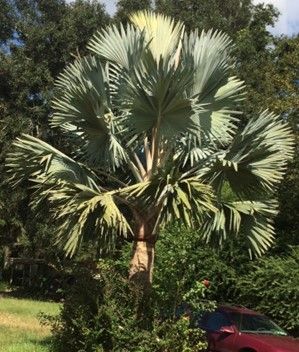
Credit: Marc Frank, UF/IFAS
Bismarck palms are considered to be hardy down to about 30°F or USDA cold hardiness zone 10A (see http://planthardiness.ars.usda.gov/PHZMWeb/), but often survive in protected sites in zone 9B (25°F). This species is not as resistant to windstorm damage as most other species of palms. They are highly drought tolerant and moderately tolerant of salt spray on the leaves. These palms grow well on a wide variety of soils, but are susceptible to potassium deficiency (see https://edis.ifas.ufl.edu/ep269) which causes translucent yellow-orange or necrotic spotting (Figure 2) and/or leaflet tip necrosis on the oldest leaves (Figure 3). Potassium deficiency also causes premature leaf death and can reduce the number of leaves that the palm can support.
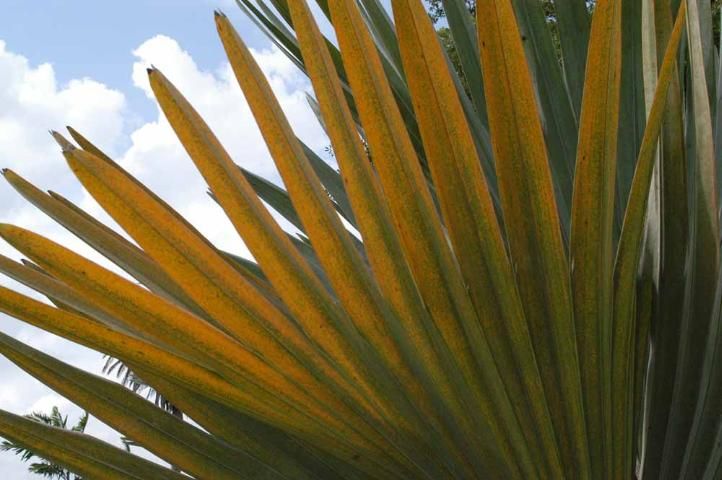
Credit: T. K. Broschat, UF/IFAS
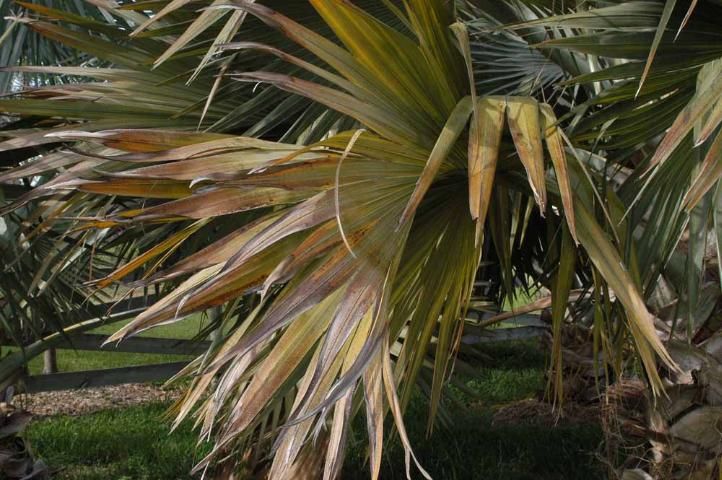
Credit: T. K. Broschat, UF/IFAS
Magnesium deficiency (see https://edis.ifas.ufl.edu/ep266) is occasionally observed in this species where it imparts an unusual light yellowish tint to the silvery leaves (Figure 4). Manganese deficiency (see https://edis.ifas.ufl.edu/ep267) has been reported on Bismarckia, but it is not common. Symptoms include chlorosis, necrotic streaking, and leaf tip necrosis of the youngest leaves (Figure 5). The only other nutritional problem encountered in Bismarck palms is boron deficiency (see https://edis.ifas.ufl.edu/ep264). In transient mild cases, this will be expressed as one or more necrotic bands around the newly emerging leaves (Figure 6). Chronic boron deficiency is fairly common in this species and typically results in spear leaves not opening properly, with more than one unopened spear leaf being present at any given time (Figure 7). In more severe cases, new leaves may be stunted and distorted. Nutrient deficiencies in the landscape can be corrected or prevented by regular use of a controlled-release granular fertilizer having an analysis of 8-2-12-4Mg plus micronutrients. See Fertilization of Field-grown and Landscape Palms in Florida (https://edis.ifas.ufl.edu/ep261) for more information about palm fertilization.
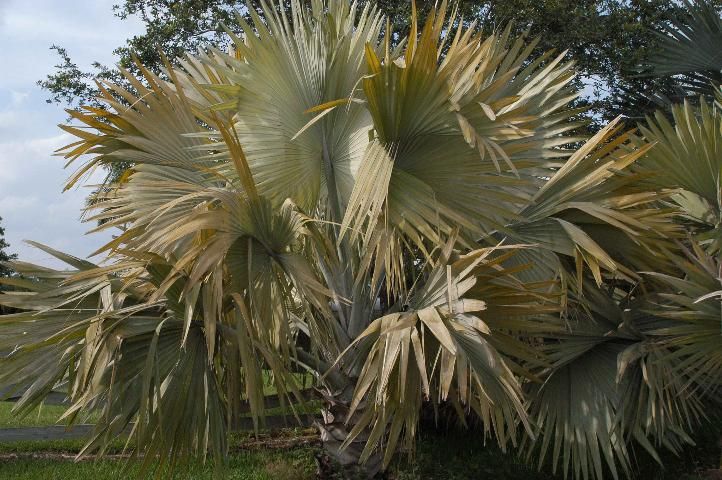
Credit: T. K. Broschat, UF/IFAS

Credit: Scott Schultz
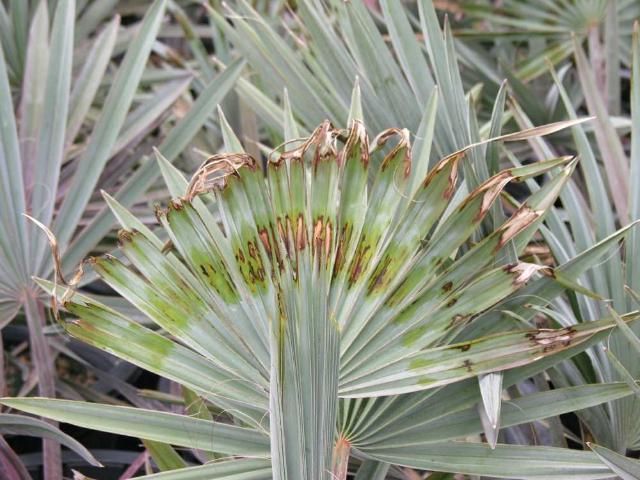
Credit: T. K. Broschat, UF/IFAS
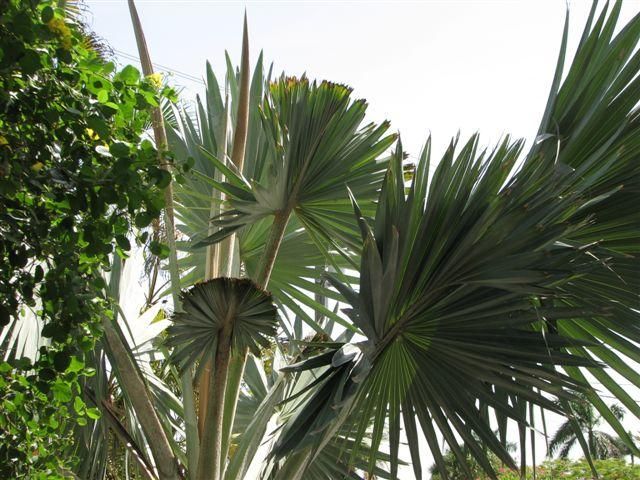
Credit: T. K. Broschat, UF/IFAS
Bismarck palms are propagated by seeds that germinate slowly over a period of 6 to 12 months at high temperatures (90°F–100°F). For more information about germinating palm seeds see Palm Seed Germination (https://edis.ifas.ufl.edu/ep238). They grow rather slowly when young but once they develop a trunk, growth rate is more moderate. Mature field-grown specimens are more difficult to transplant than most other species of palms. Landscapers have achieved reasonably good transplant success by root-pruning the palms several months prior to moving them, by digging unusually large root balls, or by removing all of the leaves at the time of moving. See Transplanting Palms (https://edis.ifas.ufl.edu/ep001) for more information on this topic.
Bismarck palms can be pruned at any time of the year, but only completely dead leaves should be removed by cutting the petiole close to the trunk. Avoid cutting leaves that are only partially dead, as these are serving as a supplemental source of potassium to the palms. Cutting living leaves also releases a volatile chemical that serves as an attractant for palmetto weevils (Rhynchophorus cruentatus) (see https://edis.ifas.ufl.edu/in139), which will lay their eggs in the leaf bases. The resulting larvae then burrow into the palm trunk in the vicinity of the meristem or bud and can kill the palm (Figure 8). Bismarck palms are highly attractive to this pest, especially when stressed by cold temperatures, transplanting, or other environmental factors.

Credit: Stephen Brown, UF/IFAS
Bismarck palms appear to be fairly disease resistant, but like all palms, are susceptible to Ganoderma butt rot (see https://edis.ifas.ufl.edu/pp100), a fungal disease caused by Ganoderma zonatum. This disease causes decay in the lower part of the trunk that can result in instability of the palm and invariably its death. A brown and white shelf-like mushroom called a conk may or may not be present on the palm trunk before it dies. This disease is not treatable or preventable.
References
Elliott, M. L., T. K. Broschat, J. Y. Uchida, and G. W. Simone (eds,). 2004. Compendium of ornamental palm diseases and disorders. St. Paul, MN: American Phytopathological Society Press.
Meerow, A. W. 2006. Betrock's Landscape Palms. Hollywood, FL: Betrock Information Systems.